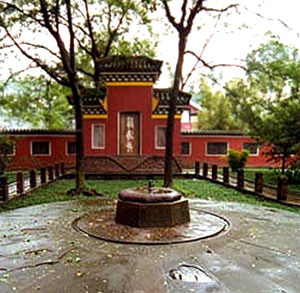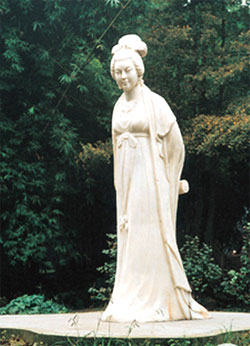In the River Viewing park, there is a well called Xue Tao Well. Legend has it that Xue Tao drew water from the well to dye a special kind of paper. Xue Tao enjoyed composing her poems on the paper she made herself that looked simple and elegant. This type of writing paper would later be known as Huanhuajian (浣花笺).

Xuetao Well
At the beginning of the Ming Dynasty, a workshop was set up on the spot to produce the Xue-Tao style writing paper. Since then the well has remained as a historical relic. A stone memorial tablet stands near the well. The three Chinese character (薛涛井 "Xue Tao Well") written in 1664 are carved on the tablet to remind visitors. The well has a sand layer at the bottom, which functions as a natural filter. The water in the well is clean and refreshing. Local people like drinking tea made with the water here in the park.
We have to retrace our steps into the bamboo forest towards a central isle around a pond. There is a white-marble statue of Xue Tao. It stands on a carpet of green grass. Xue Tao has a graceful posture in her robe, and her high hairdo resembles a hat. The set of her serene eyes, the turn of her head , and her hands emerging from the heavy sleeves, all indicate that she is walking slowly in the bamboo forest, thinking deeply how to compose her new poem.

Statue of Xue Tao at River Viewing Park
Xue Tao was born in 770, and died in 832. Her hometown was in Chang’an on the site of Xi’an. When she was young, Xue Tao moved to Chengdu with her father who obtained a job in the local government during the Tang Dynasty.
Xue Tao had shown exceptional intelligence even as a child. She began to compose poems at the age of eight. One day her father decided to test her to see if she had made any progress in her poetry composition. They stood in a yard where her father pointed at a Chinese parasol tree and orally composed the first two lines of a four-line poem. Right after her father had finished the lines, Xue Tao spoke out the other lines impromptu. Her father was very happy to hear what his daughter had responded. Here is the poem:
In the yard an old parasol tree stands,
High up into clouds.
The tree branches welcome birds from the south or north,
The leaves deliver the passing breeze.
(庭除一古桐,耸于入云中。枝迎南北鸟,叶送往来风。)
Wei Gao (韦皋), the top military commander in Sichuan sent a memorandum to the throne. In his memorandum he recommended Xue Tao for the position of official in charge of proofreading. The memorandum sincerely showed deep respect for Xue Tao. At the same time, they thought that it would be a great pity if Xue Tao were to be neglected. She was acknowledged and admired by her contemporaries for her poetic work.
By the time she was in her mid-teens, her father had died. The frustration in her lifetime began. It is reported that once she was banished to Song Zhou on the site of Songpan (松潘) country in AbaTibetan and Qiang Autonomous Prefecture. She went there to serve a prison sentence for her guilt. It was a long distance trip along snow-covered mountains and deep valleys. It was in winter, and there was a cold nip in the air. Xue Tao composed a number of her poems to express the circumstances.
Xue Tao finally came back to Chengdu from the Tibetan area. Afterwards she secluded herself in the west suburb of Chengdu. She continued to write poetry and remained a respected literary figure. When she died, she was buried near the park.
Xue Tao was of the scholar-gentry class and used to work as an assistant in Wei Gao’s headquarters. However, she is remembered chiefly as a female poet. Her poems appealed to others far beyond her close friends and people she knew. It is commonly said that Xue Tao composed about 500 poems, but at present, only 91 poems are in existence.
It is commonly believed that Xue Tao loved bamboo. The River-Viewing Pavilion Park has more than 150 kinds of bamboo, and the lush bamboo forests provide plenty of shade in the summer.
In 1953, the park workers started to use bamboo to create multiple perspectives and an illusion of scenery. At present the park is well known through the country mainly because the park shows a particular use of bamboo; bamboo spans the whole park. The workers also introduced into the park rare species from other provinces and countries in Southeast Asia. One of the most interesting is a square bamboo. The bamboo is basically square but with rounded edges. Among the forest, various rocks and stones are beautifully shaped like watermelons, peaches, flowers, leaves and other unique shapes. All this has added a lively and charming atmosphere to the serene bamboo forest.
Due to the close location of the park to the city, local people enjoy spending their weekend holidays in the park where they drink tea in the teahouses or expose themselves to nature by walking among the bamboo forest. |